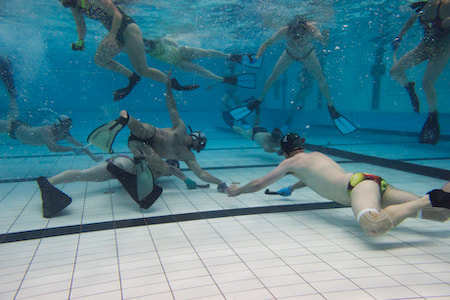Underwater hockey: sink and swim.
|
A fun, safe sport for anyone aged 10 and up
Underwater hockey combines speed, skill and teamwork in a way that you don’t find in other games. Because of the watery environment, you don’t have to be naturally athletic to be good at underwater hockey. Using a mask, snorkel and fins means you don’t even have to be a good swimmer! |
Serious or just for fun – there's a team for you
Most of us started playing underwater hockey for fun. Everyone plays on the same evening, regardless of grade, so the social side of the sport is terrific. It's easy to get hooked though. If you have a competitive streak you'll find underwater hockey to be among the most tactical and demanding of sports. Either way, you’ll find that your fitness level goes through the roof. Your water skills will improve too – you’ll be more comfortable in the pool or the ocean than ever before. |
Hockey underwater? Breathtaking fun.
|
Underwater hockey is a 3D sport
In most sports you can play to the left, to the right, forwards and backwards. In underwater hockey you also need to think about up and down. The concept is simple. Two teams, each trying to score goals against the other. |
The puck is on the bottom of the pool, and you have to push and flick it around to your team mates using a stick, all while holding your breath.
To make things even more challenging, you can't yell "flick it to me!" when you're underwater – your team needs to wordlessly work together to score a goal. |
|
Two teams of six players face off from opposite ends of the court, holding on to the pool wall. When the buzzer sounds it's a race to the puck, which has been placed in the centre of the court on the pool bottom. The player who gets there first takes control of the game (at least momentarily). Through speed, cunning and skill it's then a matter of outmanoeuvring the opposition to get the puck into your opponent’s goal.
Good teamwork is crucial. You need to be in the right place at the right time, carefully work out when to dive and when to come up for air and be ready to sprint when someone gets a lucky break. When a goal is scored, each team returns to their respective end of the court ready for another swim-off. The game is played in two 15-minute halves, with a short break in the middle, and it’s carefully controlled by in-water referees. When they need to stop play they sound an underwater buzzer. Teams are mixed – even at the top level – although there are separate men's and women's teams at national and world competitions. Underwater hockey is fast, lung-busting fun that gives your tactical brain a real workout too. |
|
Do I have to be able to hold my breath for a long time? No! If you can make it to the bottom of the pool, you can play underwater hockey. You'll find that even elite players don't spend more than a few seconds at a time on the bottom. Of course, as your skills improve you'll become faster and be able to stay down longer. Do I need to be a strong swimmer? No! Snorkelling is 'easier' than swimming. You can comfortably swim for a long time with a mask, snorkel and fins. A poor swimmer can still excel at underwater hockey. |
What gear do I need? Mask, snorkel and fins, a stick, a protective glove, a cap and a mouthguard. We can lend you this stuff if you come along to try out underwater hockey, but you'll soon want your own gear. Oh, and don't forget your bathers. Is underwater hockey safe? Absolutely. Injuries are very rare. One great thing about underwater hockey is that it's very easy on your body – there's not nearly so much stress on your joints as you find in land sports. We have players well into their sixties still going strong. |
Our senior competition runs on Wednesday evenings from March till November. There are three grades, C grade being the entry level. We're currently developing our schools competition too, with a plan to run a juniors competition on Thursday nights.


